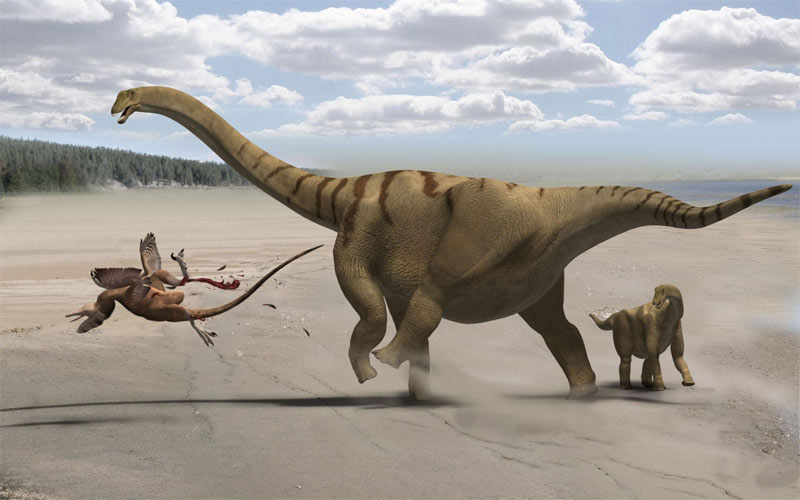How Dinosaurs Grew So Huge

How did some dinosaurs reach such soaring heights -- up to 100 feet high in some cases? Efficient lungs and respiration, along with egg laying, might have given dinos a growth edge when compared to other animals, suggests new research.
The study also negates a popular theory that animals tended to become bigger over the course of their evolution.
While some dinosaurs grew ever larger over subsequent generations, not all did.
NEWS: New Dino May Be World's Smallest
"We look at the early history of archosaurs, including some early dinosaurs," said Roger Benson who co-authored the study published in the Proceedings of the Royal Society B. "We can see that some lineages obtained gigantic body sizes, but others remained small and a few showed evolutionary size reductions."
Benson, a vertebrate paleontologist at the University of Cambridge, explained that "pterosaurs, the flying reptiles, are a good example of a lineage that remained small during our study interval. There were also many small herbivores, like the dinosaur Heterodontosaurus, and small predators like the dinosaur Coelophysis."
Benson and colleagues Roland Sookias and Richard Butler analyzed more than 400 species spanning the Late Permian to Middle Jurassic periods. The animals' pattern of growth during 100 million years supports a theory called "passive diffusion." This just means that various evolutionary lineages did a bunch of different things, from growing larger to growing smaller.
Get the world’s most fascinating discoveries delivered straight to your inbox.
The findings counter a theory known as "Cope's rule," which claims that some groups, such as dinosaurs, tended to always evolve bigger bodies over time.
There is no question, however, that many dinosaurs were mega huge, at least when compared to today's land animals.
"Several aspects of dinosaurian biology may have allowed them to obtain larger maximum sizes than any other land animals," Benson said.
"For example, in many dinosaurs, parts of the skeleton contained air, and we think they had an efficient bird-like lung. These features helped them to support their weight on land more easily, and made their respiration and heat exchange more effective than in mammals."
Benson adds that since larger animals can lay more eggs and reproduce more quickly, there may have been a reproductive advantage to being big.
Brian McNab, a professor of zoology at the University of Florida, has also studied dinosaur growth trends. He thinks the biggest dinos ate often and moved little.
NEWS: Blue Whales Keep Getting Bigger
"The large herbivorous dinosaurs undoubtedly spent much of their day feeding," McNab told Discovery News. "One should notice that the heads of dinosaurs related to the size of the bodies were very small, which means that the dinosaurs spent little time chewing the food, so most processing occurred in the gut, therefore the process of eating was probably inexpensive."
"This is very different from the behavior of most herbivorous mammals, which have large heads that house many teeth and spend much time chewing," McNab explained.
Benson thinks it's unlikely that any land animals today, including humans, could ever evolve to become as large as the biggest dinosaurs were.
"Mammals, including humans, are warm-blooded and generate a lot of heat internally," he explained. "This becomes a problem at large body sizes as there is a danger of overheating. It's possible that many extinct archosaurs, including dinosaurs, were intermediate between cold-blooded and warm-blooded physiologies."
"If so, then temperature physiology would not have imposed limits on their body size," he added. "But it would certainly limit that of giant humans."
This article was provided by DiscoveryNews.
 Live Science Plus
Live Science Plus





